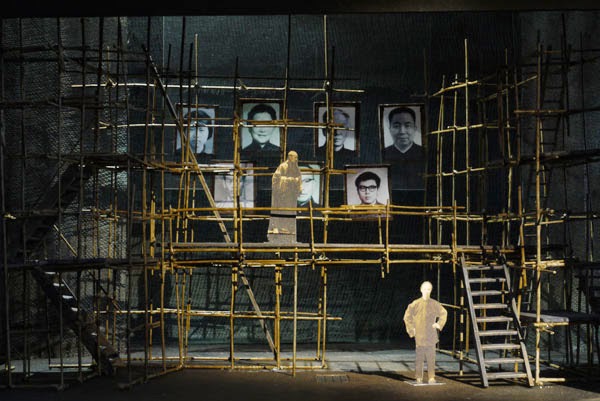The History of The Orphan of Zhao
By
Shannon Stockwell
 |
Orphan of Zhao Set Model
Set Design by Daniel Ostling
|
James Fenton said of the process of adapting The
Orphan of Zhao, “There seems to be nosingle text that presents the whole story from start to finish. It is a livingpiece of drama—continuously evolving and mutating.” Indeed, the
tale has gone through many permutations, passed from country to country,
translated from Chinese to French to English and back to Chinese again, leaving
us with as many interpretations as there are adaptations. The origins of the
tale reach back impossibly far, all the way back to the seventh century BCE.
The Orphan of Zhao is based on
actual events that occurred during the Spring and Autumn era (722–481 BCE),
which is a subdivision of the Zhou dynasty (1046–256 BCE). The Spring and
Autumn era is named after Chunqiu, or Spring and Autumn Annals,
which record the history of the small state of Lu during the years 722 BCE to
481 BCE. The earliest known roots of the Orphan of Zhao story are found
in the Zuo Zhuan, or Zuo’s Commentary, which was written by an
unknown author during the Warring States period (475–221 BCE). This detailed
expansion of the Chunqiu includes accounts of a great minster named Zhao
Dun who tried to reason with the corrupt Duke Ling, who was needlessly cruel to
his subjects, even killing them for sport.
There is no mention of an orphan in the Zuo
Zhuan; that part of the story first appeared in the Shiji, or Records
of the Grand Historian, written by second-century BCE historian Sima Qian. The
chapter titled “Noble Family of Zhao” tells of the rescue of the Orphan of
Zhao, who is, in this account, Zhao Dun’s grandson. This story also introduces
Tu’an Gu, the duke’s power-hungry minister, and Cheng Ying, a friend of the
Zhao family who rescues the orphan from his awful fate.
 |
| Orphan of Zhao Set Model Set Design by Daniel Ostling |
The Shiji’s tale of good versus evil, honor,
loyalty, and revenge caught the attention of many Chinese authors over time, so
the story was already well-known among the Chinese public by the time an
otherwise unremarkable Yuan dynasty (1271–1368) playwright, Ji Junxiang, wrote a
stage adaptation. His play was catalogued in the library of a Ming dynasty
emperor in the early fifteenth century. In 1735, a French translation was
published by a Jesuit priest who had traveled to China as a missionary. This
translation, though somewhat unfaithful to the Chinese original in terms of
style, inspired many more adaptations in several European languages.
While the “vogue” of Chinese culture fell out of favor with the European public near the end of the eighteenth century, the story of The Orphan of Zhao has captured the attentions of audiences throughout time. The twentieth century saw several new adaptations and translations, not only in China but across the world. The dramatic story of revenge, sacrifice, and loyalty has endured for almost 3,000 years, and to James Fenton, it is no mystery why: “The story has resonances throughout the world: I have often thought of Cambodia; others might think of Uganda, or Rwanda. There is, of course, the recent history of China itself. One doesn’t need to insert these echoes. They resonate on their own behalf.”
While the “vogue” of Chinese culture fell out of favor with the European public near the end of the eighteenth century, the story of The Orphan of Zhao has captured the attentions of audiences throughout time. The twentieth century saw several new adaptations and translations, not only in China but across the world. The dramatic story of revenge, sacrifice, and loyalty has endured for almost 3,000 years, and to James Fenton, it is no mystery why: “The story has resonances throughout the world: I have often thought of Cambodia; others might think of Uganda, or Rwanda. There is, of course, the recent history of China itself. One doesn’t need to insert these echoes. They resonate on their own behalf.”
Read more about A.C.T.'s production of The Orphan of Zhao in Words on Plays! Click here to purchase a copy.

